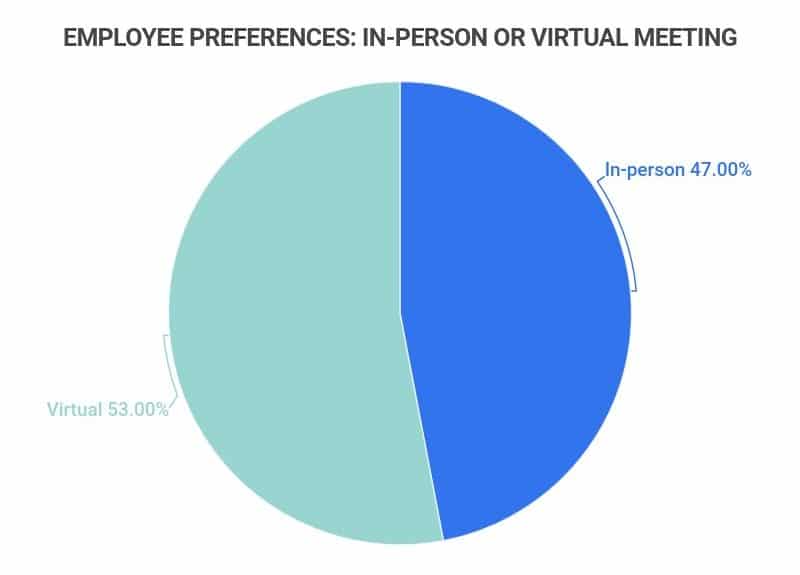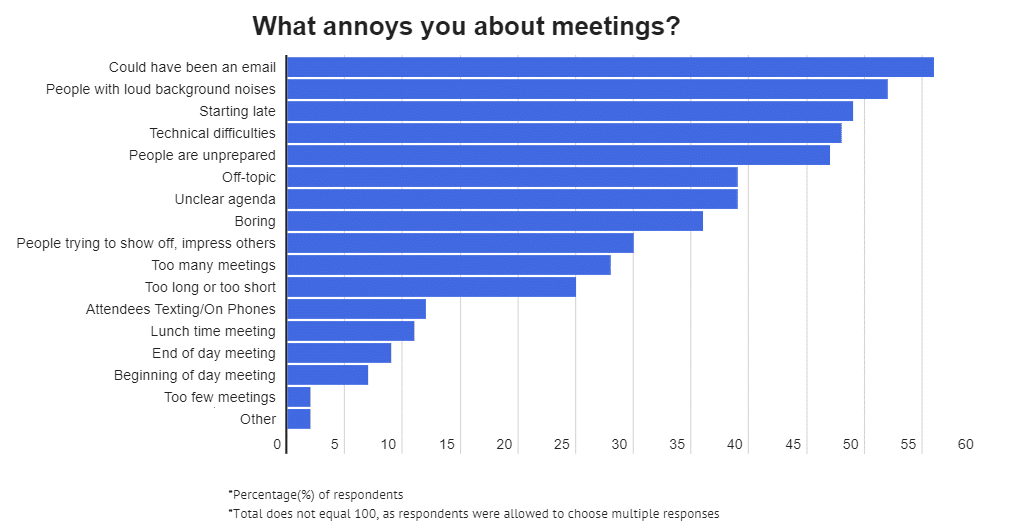- Workplace Statistics
- Time Management Statistics
- Employee Wellness Statistics
- Employment Discrimination Statistics
- Employee Recognition Statistics
- Employee Referral Statistics
- Workplace Violence Statistics
- Gamification Statistics
- Employee Feedback Statistics
- Agile Statistics
- Productivity Statistics
- Meeting Statistics
- Cell Phones At Work Statistics
- Social Media At Work Statistics
- Workplace Injury Statistics
- Workplace Stress Statistics
- Leadership Statistics
- Workplace Collaboration Statistics
- Job Satisfaction Statistics
- Paid Holiday Statistics
- Communication In The Workplace Statistics
- Wasting Time At Work Statistics
- 4-day Workweek Statistics
Meeting research summary. Meetings are a daily or weekly part of the regular schedule for most workers. However, these meetings might actually be detrimental to the workplace, especially if they have no clear purpose. According to our extensive research:
-
In the United States, there are around 55 million meetings held each week. That’s at least 11 million per day and over 1 billion per year.
-
The average time spent in meetings per week is 3 hours, with 30% of workers reporting that they spend over 5 hours per week in meetings.
-
Organizations spend roughly 15% of their time on meetings, with surveys showing that 71% of those meetings are considered unproductive.
-
An estimated $37 billion is lost per year to unproductive meetings.
-
Workers spend an average of 31 hours per month in unproductive meetings.
For further analysis, we broke down the data in the following ways:
Employee Opinions | Job Level | Virtual vs. In-Person | Unproductive Meetings | Trends

General statistics on meetings
Meetings are a common way to spend the work day, and now that we know some essential facts, let’s go over the basics. The truth is that meetings consume an excessive number of hours for many employees, and a majority of these meetings are unproductive. Here are some insights our research uncovered:
-
24 billion hours are wasted each year as the result of unproductive meetings.
And at least 37% of employees consider unproductive meetings to be the highest cost to their organization. It’s no wonder — 24 billion is a considerable amount of productive work hours being lost.
-
The average corporate employee spends four hours preparing for and attending meetings per week.
58% of employees report that their meetings last over 30 min. And, 35% of employees agree that the two to five hours wasted on meetings each week leaves them with no benefits.
-
The average employee participates in at least eight meetings per week.
That’s more than one meeting every single day and only increases with seniority. In fact, the average executive manager attends at least 12 meetings per week.

Meeting statistics by employee opinions
Meetings might seem like a waste of time on some days, but what do employees think? Well, for the most part, workers have negative opinions on meetings. Here are some insights our research uncovered:
-
65% of employees agree that meetings prevent them from completing their own work.
And it’s not surprising that two out of three employees hold this opinion because other surveys have shown that those higher up on the ladder can spend up to 50% of their time in meetings.
-
Employees multitask in at least 41% of meetings.
Most multitasking in remote meetings involves email checking, where employees answer and write emails during a meeting. At least 55% of employees perform this type of multitasking, which is also more likely to occur when meetings are longer.

-
45% of employees feel overwhelmed by the number of meetings they attend.
This isn’t surprising, considering that the average employee attends at least eight meetings per week. One of the best ways to reduce this is by limiting the number of people in meetings.
When only five to eight people attend, as opposed to 100, only the people who will actually contribute should attend. This also ensures that the people who don’t attend won’t have their time wasted.
-
39% of employees surveyed have slept during a work meeting.
And that figure is even worse for daydreaming, as at least 91% of employees daydream during work meetings.
Meeting statistics by job level
When it comes to meetings, not all job titles are created equal. Those higher up on the ladder tend to spend far more time in meetings. Plus, some fields are far more likely to have more meetings than others. Here are the facts:
-
The average CEO has at least 37 meetings per week, and that’s 72% of their time.
Overall, corporate jobs higher up the ladder tend to require more and more meetings. Middle management employees spend roughly 35% of their time in meetings, while upper management spends 50% of their time in meetings.
-
35% of employees spent two to five hours per day dealing with meetings and calls.
And per day, most employees (54%) spend over 30 minutes in each meeting they have. This is a considerable amount of time to take from an eight-hour workday.
-
Office jobs have the most meetings compared to other fields, with Vice Presidents and CEOs having about 17 meetings per week.
Compared to the average of eight meetings per week, Vice Presidents other top-level executives can experience between 12-17 meetings per week. That’s 53% more meetings per week than the average employee.
Virtual vs. in-person meeting statistics
Remote work meetings became the norm during the COVID-19 Pandemic. This came with a whole new set of struggles, from tech issues to an excessive number of people on zoom calls. Here’s what we found:
-
Since the start of COVID-19, 50% of employees have had at least one to three hours of virtual meetings per week.
While this is a smaller average than that of in-person meetings, it still comes with some issues. Many remote employees are annoyed with the amount of time lost to starting late or technical issues, with just under 50% complaining about both of these issues.
-
47% of workers prefer in-person meetings.
This is saying something, considering the fact that 90% of Americans want fewer meetings in the workplace.
-
Over 55% of remote workers think that a majority of meetings “could have been an email.”
And this is just the most common pet peeve among workers. Other annoyances include: “people with loud background noises,” as well as unprepared people and off-topic discussions.
-
15% of remote workers perform house chores during online meetings.
And there are plenty of other distracting tasks people do as well, such as childcare, pet care, going for a jog, and more. While these cases aren’t in the majority, many account for just under 10% of respondents.
-
The number of unique global visitors to Zoom dropped from 1.8 million in January 2022 to 1.3 million in May 2022.
This was after the site saw its visits increase from 1.4 million in December 2021 to 1.8 million in January 2022.
-
42% of Zoom users say they’ve attended a virtual meeting from their beds.
In addition, 21% take Zoom meetings while they’re out walking or jogging, and 11% attend meetings while on public transportation. Here are some additional Zoom statistics:
Zoom meeting statistics from november 2020 to november 2021
Zoom Meeting Variable Percentage of Zoom Users Wave at the End of a Zoom Meeting 75% Have Said, “You’re on Mute” 71% Dress Casually for Zoom Meetings 68% Say It’s Never Okay to Eat During a Meeting 47% Attend Meetings From Bed 42% Don’t Shower Before Meetings 26% Attend Meetings While Walking or Jogging 21% Attend Meetings While on Public Transportation 11%


Meetings statistics by unproductive meetings
It’s not looking good for work meetings, and one of the true nails in the coffin is likely costs. From taking productive time away from workers to paying for that group pizza, meetings can hit a business hard. Here’s what we found:
-
U.S. businesses lose a combined $37 billion a year to unnecessary meetings.
For perspective, that cost can be worth roughly 300,000 hours of work each year. Alone, one big business can also easily lose up to $300 million on useless meetings.
-
At least 30% of workers believe that their ideas are shut down far too quickly in meetings
Excessive and unproductive meetings really damage morale, especially when certain voices aren’t heard or listened to. On top of that, the hours of productivity lost can also make it harder for employees to work.
-
Only 37% of workplace meetings actively make use of meeting agendas.
This isn’t great, considering the fact that agendas are crucial for keeping everyone on task and keeping meetings as brief as possible.
-
Often, employees and managers spend an equal amount of time preparing for a meeting as they attend it.
That means for every 30 minutes of a meeting, there was also 30 minutes of prep time. Talk about time-consuming.
Meeting trends and projections
So, what does the future hold for meetings? While there has been an obvious trend toward digitization, the fact is that people prefer face-to-face. With that in mind, it’s unclear how meetings will change going forward. However, we discovered that:
-
From 2020 to 2021 alone, the number of meetings attended by workers has increased by 12.9%
This is likely due to an increase in online meetings, as opposed to face-to-face ones. However, just because people are attending more meetings, that doesn’t mean those meetings are longer.
-
The average length of meetings has decreased by 20.1%.
This means that in 2021, workers spent around 11.5% less of their working time in meetings each day.
-
Since the start of 2020, the number of people attending meetings has increased by 13.5%.
This isn’t necessarily a good thing, considering the fact that the optimal number of people per meeting is only five to eight attendees.
-
The global video conferencing market is expected to see a CAGR of 11.45% between 2020 to 2026, which is considerable.
From 2019 to 2021 alone, the value of the global video conferencing market increased from $3.85 billion to $6.03 billion. That’s a value increase of 36%.
Meeting statistics by pre- and post-lockdown
| Variable | Pre-Lockdown Average | Post-Lockdown Average |
|---|---|---|
| Total Meeting Hours | 2.7 hours | 2.5 hours |
| Meeting Count | 5.9 meetings | 6.9 meetings |
| Meeting Attendence | 15.6 attendees | 17.7 attendees |
| Single Meeting Length | 1 hour | 0.8 hours |
Meeting statistics FAQ
-
What percentage of meetings are productive?
Only 11% of meetings are productive. Unfortunately, only a small portion of meetings are productive, despite the fact that organizations spend roughly 15% of their time on meetings. In fact, the vast majority, or 71%, are considered unproductive.
-
What percentage of time is spent in meetings?
About 6% is spent in meetings — 2.5 meeting hours per week, divided by a 40-hour workweek. However, the percentage of time spent in meetings varies considerably based on the job title and level. The average CEO spends up to 72% of their time in meetings, which is the highest of any position.
Overall, corporate jobs higher up the ladder tend to require more and more meetings. Middle management employees spend roughly 35% of their time in meetings, while upper management spends 50% of their time in meetings.
-
What is the average number of meetings in a week?
The average white-collar employee has at least 8 meetings per week. However, this number can increase to as high as 17 for VPs, Executives, and CEOs.
-
What is the ideal meeting length?
The ideal meeting length is about 15 minutes. Studies show that in meetings that are no longer than 15 minutes, 91% of attendees are paying attention. This number steadily declines until it reaches only 64% in meetings over 45 minutes.
-
How do you improve work meetings?
You improve work meetings by determining the reason for the meeting beforehand, setting and distributing an agenda before the meeting, and limiting the meeting attendees to 10, maximum. As Amazon CEO Jeff Bezos says, “if you need more than two pizzas to feed everybody, there are too many people.”
If you’re not in a position to control the meeting’s logistics and are just attending the meeting, be sure to understand the agenda, make concise but meaningful contributions, and listen to others speak so that you understand what your team is working on and can ask questions/make comments when appropriate.
Another famous CEO, Elon Musk, is quoted as telling his employees to “walk out of a meeting or drop off a call as soon as it is obvious you aren’t adding value — it is not rude to leave, it is rude to make someone stay and waste their time.” Whether or not that’s an option at your place of employment is another matter.
-
Types of meetings include status updates, info-sharing, decision-making, problem-solving, team-building, and innovation. While these meetings have their place in the world of work, some professions, roles, and job levels will lean heavily toward certain types of meetings.
For example, a software engineer will likely have meetings that are more focused on problem-solving, while an exectuive or manager will hold more meetings to make decisions and hear status updates from subordinates.
Conclusion
Meetings in their current state aren’t doing wonders for American workers. At least 65% of employees agree that meetings prevent them from completing their own work, and 45% of employees feel overwhelmed by the number of meetings they attend.
This is no good when you consider how much time is being dedicated to meetings. 55 million meetings happen every single week in the U.S., and organizations dedicate 15% of their time to them. However, 71% of the meetings are considered unproductive, and a combined loss of $37 billion is spent annually on unnecessary meetings.
Clearly, something has to change. The statistics generally show that shorter meetings with fewer people could be the solution for a start, as participants would be far more engaged and productive.
References
-
Attentiv. “America Meets a Lot. An Analysis of Meeting Length, Frequency, and Cost.” Accessed on September 19th, 2021.
-
Doodle. “The State of Meetings 2019.” Accessed on September 19th, 2021.
-
BOOQED. “Minutes (Wasted) of Meeting: 50 Shocking Meeting Statistics.” Accessed on September 19th, 2021.
-
Harvard Business Review. “Stop the Meeting Madness.” Accessed on September 20th, 2021.
-
Zippia. “Virtual and Zoom Meeting Distraction Statistics [Survey].” Accessed on September 20th, 2021.
-
Atlassian. “You Waste a Lot of Time at Work.” Accessed on September 20th, 2021.
-
The Muse. “How Much Time Do We Spend in Meetings? (Hint: It’s Scary).” Accessed on September 20th, 2021.
-
Jell. “The Financial Value of Productive Meetings.” Accessed on September 20th, 2021.
-
Ragan. “Survey: Jargon, ‘pointless’ meetings hurt morale, productivity.” Accessed on September 20th, 2021.
-
Cornerstone Dynamics. “Meeting Stats That May Surprise You.” Accessed on September 20th, 2021.
-
Avoma. “The Time Spent on Managing (Not Attending) Meetings is More Than 15%.” Accessed on September 20th, 2021.
-
NBER. “Collaborating During Coronavirus: The Impact of COVID-19 on the Nature of Work.” Accessed on September 20th, 2021.
-
Grand View Research. “Video Conferencing Market Worth $9.95 Billion By 2028 | CAGR: 11.4%.” Accessed on September 20th, 2021.
-
Statista. “Worldwide Visits to Zoom.us From December 2021 to May 2022.” Accessed on February 14, 2023.
-
Zoom Blog. “Here’s How You Zoomed Over the Past Year.” Accessed on February 14, 2023.
- Workplace Statistics
- Time Management Statistics
- Employee Wellness Statistics
- Employment Discrimination Statistics
- Employee Recognition Statistics
- Employee Referral Statistics
- Workplace Violence Statistics
- Gamification Statistics
- Employee Feedback Statistics
- Agile Statistics
- Productivity Statistics
- Meeting Statistics
- Cell Phones At Work Statistics
- Social Media At Work Statistics
- Workplace Injury Statistics
- Workplace Stress Statistics
- Leadership Statistics
- Workplace Collaboration Statistics
- Job Satisfaction Statistics
- Paid Holiday Statistics
- Communication In The Workplace Statistics
- Wasting Time At Work Statistics
- 4-day Workweek Statistics





